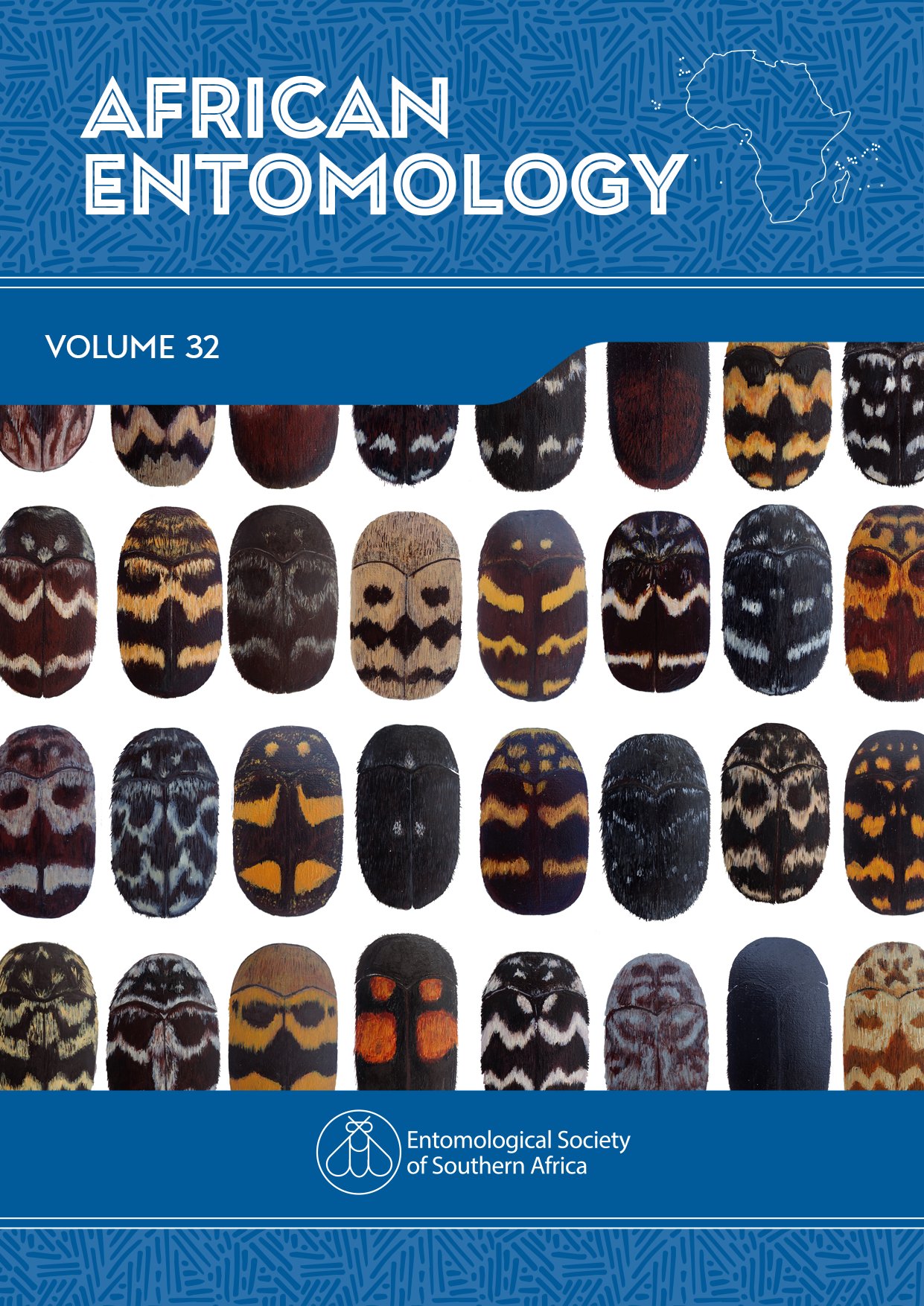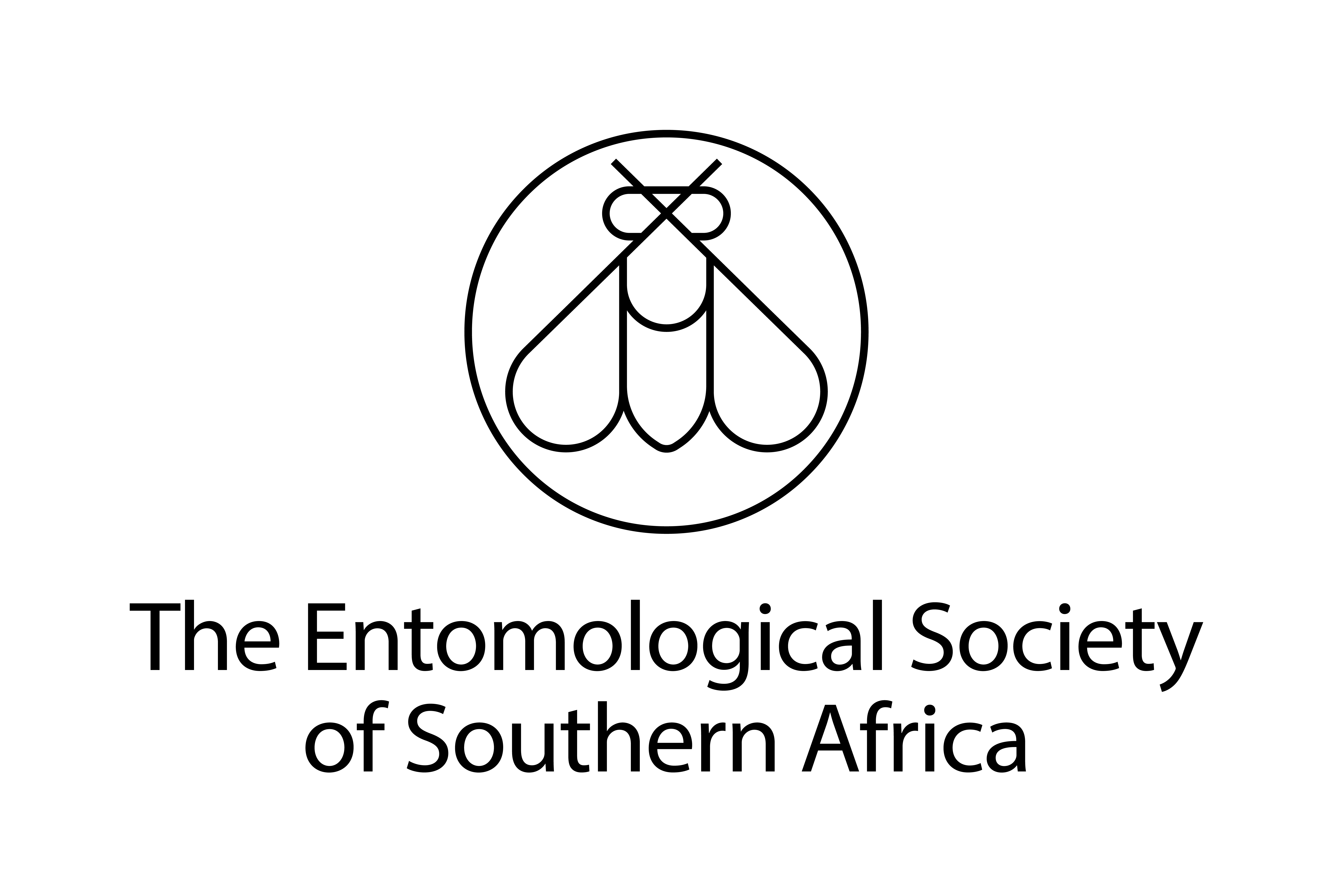The addition of molasses to the Cryptophlebia leucotreta granulovirus formulation improves its efficacy against Thaumatotibia leucotreta Meyrick (Lepidoptera: Tortricidae), a pest of citrus in South Africa
DOI:
https://doi.org/10.17159/2254-8854/2024/a17650Keywords:
CrleGV, Cryptogran™, false codling moth, insect pest management, phagostimulantAbstract
Thaumatotibia leucotreta (Meyrick) (Lepidoptera: Tortricidae), commonly referred to as false codling moth, is an important pest of citrus in southern Africa. Given its quarantine status in markets to which a large portion of the fresh produce is exported, its management in citrus orchards is essential. This management typically follows a systems approach in which baculovirus-based biopesticides, such as Cryptogran™ (Betabaculovirus cryleucotreta), are considered an important component of pre-harvest control strategies. It has previously been demonstrated that adding molasses with Cryptogran™ improves field performance, further reducing the number of T. leucotreta infested fruit. However, the reason for this improvement was never determined. This study aimed to understand the role that molasses may have on the behaviour of T. leucotreta first instars under laboratory conditions, leading to this improved field efficacy, and to confirm conclusively if the addition of molasses to the virus formulation improved efficacy across a further six field trials. In the laboratory, larvae exposed to molasses-treated oranges at either a concentration of 0.25% or 0.50% moved around the surface of the oranges less and also penetrated the oranges less compared to larvae exposed to non-molasses-treated oranges. This suggested that molasses, as a phagostimulant, encouraged larval feeding quicker and longer. This will promote the uptake of the biopesticide infective units and is likely the reason for the recorded improved field efficacy of Cryptogran™ when combined with molasses across all six field trials compared to its application alone. These two sets of experiments confirm conclusively that the addition of molasses to the virus formulation improves its efficacy and should be standard practice in the industry.
Downloads
References
Adom M, Fening KO, Billah MK, Wilson DD, Hevi W, Clottey VA, Ansah-Amprofi F, Bruce AY. 2021. Pest status, bio-ecology and management of the false codling moth, Thaumatotibia leucotreta (Meyrick) (Lepidoptera: Tortricidae) and its implication for international trade. Bulletin of Entomological Research. 111:17–30. https://doi.org/10.1017/S0007485320000358.
Ballard J, Ellis DJ, Payne CC. 2000. The role of formulation additives in increasing the potency of Cydia pomonella granulovirus for codling moth larvae, in laboratory and field experiments. Biocontrol Science and Technology. 10(5):627–640. https://doi.org/10.1080/095831500750016424.
Burges HD, Jones KA. 1998. Formulation of bacteria, viruses and protozoa to control insects. In: Burges, HD, editor. Formulation of Microbial Biopesticides: Beneficial Microorganisms, Nematodes and Seed Treatments. Dordrecht: Kluwer Academic; p. 33–127.
Cunningham GP, Harden J. 1998. Reducing spray volumes applied to mature citrus trees. Crop Protection. 17(4):289–292. https://doi.org/10.1016/S0261-2194(98)00007-6.
Cisneros J, Pérez JA, Penagos DI, Ruiz V J, Goulson D, Caballero P, Cave RD, Williams T. 2002. Formulation of a nucleopolyhedrovirus with boric acid for control of Spodoptera frugiperda (Lepidoptera: Noctuidae) in maize. Biological Control. 23:87–95. https://doi.org/10.1006/bcon.2001.0985.
Citrus Growers’ Association. 2023. Industry Statistics. Available from: http://c1e39d912d21c91dce811d6da9929ae8.cdn.ilink247.com/ClientFiles/cga/CitrusGowersAssociation/Company/Documents/CGA%20Stats%20Booklet%202023%20(05_06_23)_compressed.pdf (accessed October 25, 2023).
Fox J, Weisberg S. 2019. An R Companion to Applied Regression, Third Edition. Thousand Oaks: Sage Publications. https://socialsciences.mcmaster.ca/jfox/Books/Companion/.
Grout TG, Moore SD. 2015. Citrus. In: Prinsloo GL, Uys, V, editors. Insects of Cultivated Plants in Southern Africa. Pretoria: Entomological Society of Southern Africa; p. 447–501.
Grzywacz D, Moore SD. 2017. Production, formulation, and bioassay of baculoviruses for pest control. In: Lacey LA, editor. Microbial Control of Insect and Mite Pests: From Theory to Practice. London: Academic Press; p. 109–124.
Haase S, Sciocco-Cap A, Romanowski V. 2015. Baculovirus insecticides in Latin America: historical overview, current status and future perspectives. Viruses. 7:2230–2267. https://doi.org/10.3390/v7052230.
Hattingh V, Moore S, Kirkman W, Goddard M, Thackeray S, Peyper M, Sharp G, Cronjé P, Pringle K. 2020. An improved systems approach as a phytosanitary measure for Thaumatotibia leucotreta (Lepidoptera: Tortricidae) in export citrus fruit from South Africa. Journal of Economic Entomology. 113(2):700–711. https://doi.org/10.1093/jee/toz336.
Hofmeyr JH, Hofmeyr M, Hattingh V, Slabbert JP. 2016. Postharvest phytosanitary disinfestation of Thaumatotibia leucotreta (Lepidoptera: Tortricidae) in citrus fruit: determination of ionising radiation and cold treatment conditions for inclusion in a combination treatment. African Entomology. 24(1):208–216. https://doi.org/10.4001/003.024.0208.
Kirkman W. 2007. Understanding and improving the residual efficacy of the Cryptophlebia leucotreta granulovirus (CRYPTOGRAN). MSc. Rhodes University, South Africa. Available at: http://hdl.handle.net/10962/d1005482 (accessed 12 January 2024).
Knight AL, Basoalto E, Witzgall P. 2015. Improving the performance of the granulosis virus of codling moth (Lepidoptera: Tortricidae) by adding the yeast Saccharomyces cerevisiae with sugar. Environmental Entomology 44(2):252–259. https://doi.org/10.1093/ee/nvv008.
Knox C, Moore SD, Luke GA, Hill MP. 2015. Baculovirus-based strategies for the management of insect pests: a focus on development and application in South Africa. Biocontrol Science and Technology. 25(1):1–20. https://doi.org/10.1080/09583157.2014.949222.
Kour R, Gupta RK, Hussain B, Kour S. 2022. Synergistic effect of naturally occurring granulosis virus isolates (PbGV) with phagostimulants against the cabbage butterfly, Pieris brassicae (L.) for its eco-friendly management. Egyptian Journal of Biological Pest Control. 32(1):5. https://doi.org/10.1186/s41938-022-00502-0.
Lacey LA, Grzywacz D, Shapiro-Ilan DI, Frutos R, Brownbridge M, Goettel MS. 2015. Insect pathogens as biological control agents: back to the future. Journal of Invertebrate Pathology. 132:1–41. https://doi.org/10.1016/j.jip.2015.07.009.
Lasa R, Williams T, Caballero P. 2009. The attractiveness of phagostimulant formulations of a nucleopolyhedrovirus-based insecticide depends on prior insect diet. Journal of Pest Science. 82:247–250. https://doi.org/10.1007/s10340-009-0246-0.
Lenth RV. (2023) emmeans: Estimated Marginal Means, aka Least-Squares Means. R Package v. 1.9.0. https://CRAN.R-project.org/package=emmeans (accessed: 12.01.2024).
Malan AP, Diest JI, Moore SD, Addison P. 2018. Control options for false codling moth, Thaumatotibia leucotreta (Lepidoptera: Tortricidae), in South Africa, with emphasis on the potential use of entomopathogenic nematodes and fungi. African Entomology. 26(1):14–29. https://doi.org/10.4001/003.026.0014.
Moore SD. 2021. Biological control of a phytosanitary pest (Thaumatotibia leucotreta): a case study. International Journal of Environmental Research and Public Health. 18:1198. https://doi.org/10.3390/ijerph18031198.
Moore SD. 2022. Moths and butterflies: false codling moth. In: IPM Production Guidelines (Vol III, Chapter 3: specific pests). Nelspruit, South Africa: Citrus Research International.
Moore SD, Hendry DA, Richards GI. 2011. Virulence of a South African isolate of the Cryptophlebia leucotreta granulovirus to Thaumatotibia leucotreta neonate larvae. BioControl. 56:341–352. https://doi.org/10.1007/s10526-010-9339-1.
Moore S, Jukes M. 2023. The history of baculovirology in Africa. Viruses. 15:1519. https://doi.org/10.3390/v15071519.
Moore S, Kirkman W, Hattingh V. 2015a. The host status of lemons for the false codling moth, Thaumatotibia leucotreta (Meyrick) (Lepidoptera: Tortricidae) with particular reference to export protocols. African Entomology. 23(2):519–525. https://doi.org/10.4001/003.023.0223.
Moore SD, Kirkman W, Hattingh V. 2016. Verification of inspection standards and efficacy of a systems approach for Thaumatotibia leucotreta (Lepidoptera: Tortricidae) for export citrus from South Africa. Journal of Economic Entomology 109(4):1564–1570. https://doi.org/10.1093/jee/tow139.
Moore S, Kirkman W, Richards G, Stephen P. 2015b. The Cryptophlebia leucotreta granulovirus—10 years of commercial field use. Viruses. 7:1284–1312. https://doi.org/10.3390/v7031284.
Moore S, Kirkman W, Stephen P. 2004. A virus for the biological control of false codling moth. South African Fruit Journal. 2004(Dec/Jan):56–60.
Moore S, Manrakhan A. 2022. Postharvest disinfestation treatments for false codling moth and fruit flies in citrus from South Africa. Horticulturae. 8:221. https://doi.org/10.3390/horticulturae8030221.
Moore SD, Richards GI, Chambers C, Hendry D. 2014. An improved larval diet for commercial mass rearing of the false codling moth, Thaumatotibia leucotreta (Meyrick) (Lepidoptera: Tortricidae). African Entomology. 22(1):216–219. https://doi.org/10.4001/003.022.0125.
Moscardi F. 1999. Assessment of the application of baculoviruses for control of Lepidoptera. Annual Review of Entomology. 44:257–289. https://doi.org/10.1146/annurev.ento.44.1.257.
Newton PJ. 1998. False codling moth, Cryptophlebia leucotreta (Meyrick). In: Bedford ECG, van den Berg MA, de Villiers EA, editors. Citrus Pests in the Republic of South Africa. Nelspruit: Dynamic Ad; p. 192–200.
Opoku-Debrah JK. 2012. Studies on existing and new isolates of Cryptophlebia leucotreta granulovirus (CrleGV) on Thaumatotibia leucotreta populations from a range of geographic regions in South Africa. PhD thesis. Rhodes University, South Africa.
Opoku-Debrah JK, Hill MP, Knox C, Moore SD. 2013. Overcrowding of false codling moth, Thaumatotibia leucotreta (Meyrick) leads to the isolation of five new Cryptophlebia leucotreta granulovirus (CrleGV-SA) isolates. Journal of Invertebrate Pathology. 112:219–228. https://doi.org/10.1016/j.jip.2012.12.008.
Opoku-Debrah JK, Hill MP, Knox C, Moore SD. 2016. Heterogeneity in virulence relationships between Cryptophlebia leucotreta granulovirus isolates and geographically distinct host populations: lessons from codling moth resistance to CpGV-M. BioControl. 61:449–459. https://doi.org/10.1007/s10526-016-9728-1.
Pereira-da-Conceicoa LL, Hill M, Moore S. 2012. Development of a peroral, droplet-dose bioassay laboratory technique and its application on a granulovirus for Thaumatotibia leucotreta (Lepidoptera: Tortricidae). African Entomology. 20(1):187–190. https://doi.org/10.4001/003.020.0124.
Sood P, Choudhary A, Prabhakar CS, Mehta PK. 2013. Effect of feeding stimulants on the insecticidal properties of Pieris brassicae granulovirus (PbGV) against Pieris brassicae. Phytoparasitica 41:483–490. https://doi.org/10.1007/s12600-013-0327-8.
van den Berg MA. 2001. Cryptophlebia leucotreta Meyrick. In: de Villiers EA, Joubert PH, editors. Pests and Beneficial Arthropods of Tropical and Non-Citrus Subtropical Crops in South Africa. Nelspruit: ARC-Institute of Tropical and Subtropical Crops; p. 320–325.
van der Merwe M, Jukes MD, Knox C, Moore SD, Hill MP. 2023. Naturally occurring yeasts associated with Thaumatotibia leucotreta can enhance the efficacy of the Cryptophlebia leucotreta granulovirus. Pathogens. 12:1237. https://doi.org/10.3390/pathogens12101237.
van Oers MM, Herniou EA, Jehle JA, Krell PJ, Abd-Alla AMM, Ribeiro BM, Theilmann DA, Hu Z, Harrison RL. 2023. Developments in the classification and nomenclature of arthropod-infecting large DNA viruses that contain pif genes. Archives of Virology. 168:182. https://doi.org/10.1007/s00705-023-05793-8.
Yang MM, Li ML, Zhang Ya, Wang YZ, Qu LJ, Wang QH, Ding JY. 2012. Baculoviruses and insect pests control in China. African Journal of Microbiology Research. 6(2):214–218. https://doi.org/10.5897/AJMR11.1357.
Downloads
Published
Issue
Section
License
Copyright (c) 2024 Candice Coombes, Storm Hilliar, Sean Moore, Martin Hill

This work is licensed under a Creative Commons Attribution 4.0 International License.
How to Cite
Funding data
-
National Research Foundation
Grant numbers 84643 -
Citrus Research International




.png)